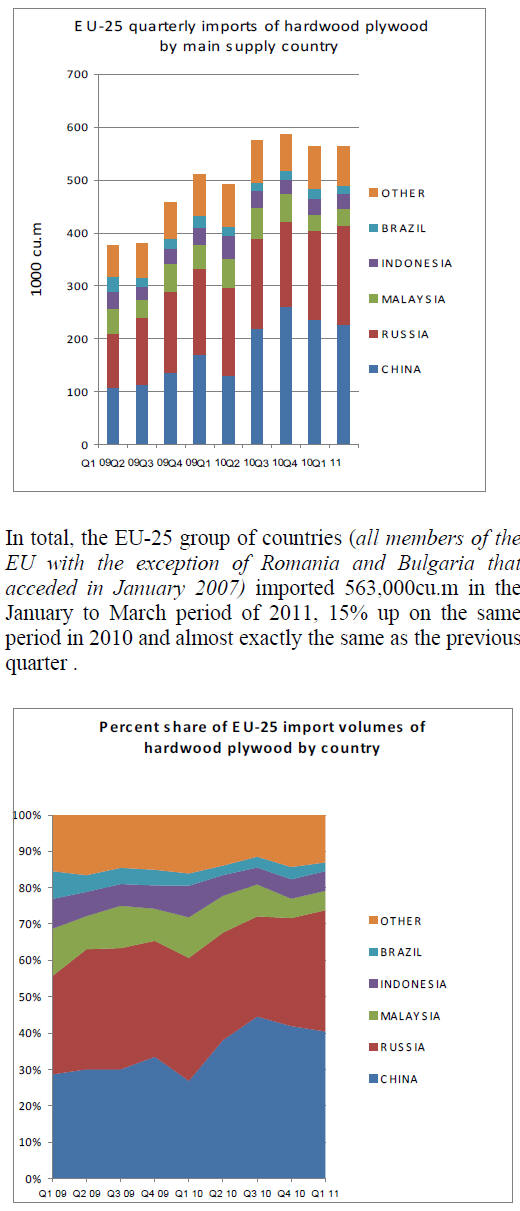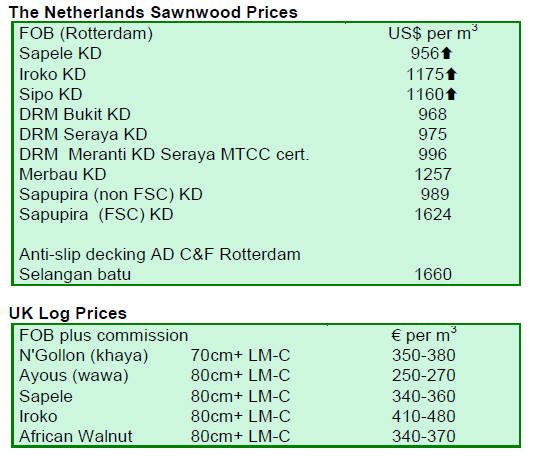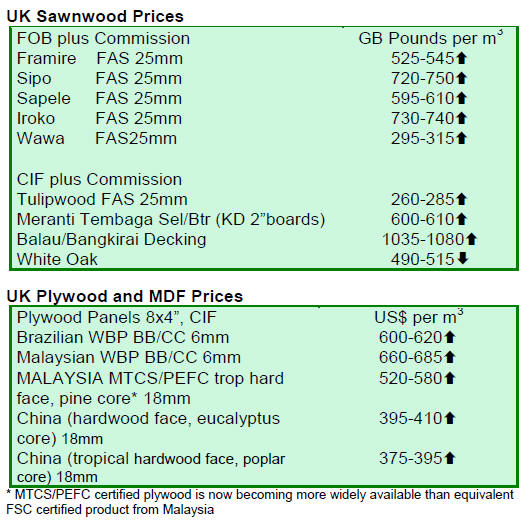|
Report
from
Europe
Tropical hardwood plywood prices at record levels
CIF Europe prices for South East Asian and Chinese
hardwood plywood increased dramatically in the second
quarter of 2011 in response to tight supplies, rising
production costs, currency movements and firm demand in
Asia.
Prices have continued to rise for July and August
shipment. Prices for Malaysian BB/CC raw plywood on
offer to European buyers now exceed Indo96+40% and
those for equivalent Indonesian products may be over
Indo96+50%, levels never seen before.
However underlying consumption of plywood in Europe is
still subdued so that few importers are experiencing
significant supply problems. In the UK, there are even
reports of importers reducing prices of their landed stock
for onward sale in an effort to generate cash before the
summer holiday season.
In this environment, most UK importers seem content to
work from their existing stock holdings and few are
showing much interest in paying the higher CIF prices.
The German journal EUWID reports a similar situation in
mainland Europe noting that ¡°rather subdued demand for
plywood imported from South East Asia on the whole has
so far staved off any major shortages in Europe.¡±
On the other hand, the UK Timber trades Journal ( TTJ)
notes that mainland European importers are showing much
greater willingness to pay the higher prices for Malaysian
and Indonesian plywood because, unlike their UK
counterparts, they ¡°are not prepared to go down the
Chinese route¡±.
UK trade switches to Chinese made plywood
The extent to which the UK has switched more to Chinese
plywood products is revealed in the import data for the
first quarter of 2011. During that period, the UK imported
109,000 cu.m of Chinese hardwood plywood compared to
only 32,000 cu.m in the same period of 2010.
UK imports of hardwood plywood during the first quarter
of 2011 from Malaysia stood at 25,000 cu.m, down from
43,000 cu.m in the same period of 2010, while imports
from Brazil were less than 5000 cu.m compared to 10,000
cu.m in the first quarter of 2010.
A different situation prevails in mainland Europe. EUWID
reports that in recent months several importers in this
region have tested Chinese birch plywood and Chinese
mixed light hardwood plywood as possible substitutes for
Indonesian and Malaysian plywood. However they
decided against placing large orders on quality grounds.
In mainland Europe, the most notable trend this year has
been a revival in imports of Russian birch plywood as the
supply situation has gradually improved after the dramatic
fall in availability following the severe forest fires in
Russia last summer.

The chart above shows the market share of countries
supplying hardwood plywood into the EU-25 since the
start of 2008 highlights that the major beneficiaries of
recent trends have been China (mainly to the UK) and
(mainly to mainland Europe).
Together these two countries now account for 74% of all
hardwood plywood imported into the EU compared to
60% at the start of 2008.
Meanwhile, the main tropical suppliers of hardwood
plywood ¨C Malaysia, Indonesia, and Brazil ¨C have seen
their combined share of EU imports fall from 28% to 13%.
European construction sector remains weak
Although the low point in European construction activity
appears to have been overcome, future growth will be at
risk from the effects of the EU debt crisis, rising inflation,
government austerity measures and the progressive
withdrawal of stimulus measures aimed to offset the worst
effects of the economic downturn.
This is the main conclusion of the 71st Euroconstruct
Conference in Helsinki, Finland on 17th June, 2011.
Between 2007 and 2010, total construction activity fell
continuously by a total of more than 15% to reach a low
not seen since 1998. This downward trend is expected to
end this year, but the performance of the sector varies
country by country.
This year construction sector growth is forecast to be
highest in Poland and the Nordic countries, while France
and Germany will also achieve reasonable growth. In
Spain, Ireland and Portugal, construction is still declining
rapidly. More moderate declines will be recorded in the
UK and a few Central and Eastern European countries.
Residential building records sharp decline
Of all sectors, the largest fall from the industry¡¯s peak year
in 2007 has been in the construction of new residential
buildings. While around 2.5 million new residential
buildings were completed in 2007 in the Euroconstruct
countries, less than 1.5 million will be completed this year.
However, the numbers of houses built across the region is
expected to sustain annual growth of slightly under 5%
from this year forward.
While office construction weathered the financial crisis
better than the housing sector, it still suffered a major
downturn. The total value of construction in the office
sector shrank by around 13% between 2007 and 2010,
while new office construction fell by almost 20%.
Office construction tends to lag behind economic trends
and it is not forecast to grow until 2012. New office
construction suffered more from the fall caused by the
financial crisis than did renovation.
The heavy decline in new build and an emphasis on
improving the energy efficiency of existing building stock
in government stimulus measures has meant that
renovation now dominates European construction activity.
The value of building renovation in Europe is currently
one and a half times that of new build.
Falling government spending from 2011 onwards will hit
construction activity particularly hard in the infrastructure
segment. Activity in this segment remained almost
unchanged between 2008 and 2009, but suffered a 5%
decline in 2010.
Infrastructure activity is expected to continue to fall during
2011, particularly in Eastern Europe as EU funding and
national investment funds are shrinking.
However, overall construction activity is projected to
remain higher in eastern than in Western Europe.
Construction activity in Western Europe is expected to
grow by 1.5% per annum until 2020, a slightly slower
pace than growth in GNP.
Weakness in construction activity in SW Europe until 2020
Relatively higher rates of growth in Nordic countries will
be offset by little or no growth in south west European
countries. A large oversupply of housing and business
premises combined with high levels of debt and
government austerity are expected to lead to weakness in
construction activity in south Western Europe at least until
2020.
During the same period, construction activity is expected
to grow by 4.5% to 5% in central Eastern Europe where
economies are closing the gap on their richer western
European neighbours.
While overall European growth in construction will be
subdued before 2020, underlying demographic and social
factors give confidence of at least stable long-term
demand, particularly in the renovation sector.
The factors supporting this assumption include: ageing
building stock, the trend towards living alone, which is
increasing the numbers of households, rising urbanisation
and tightening energy efficiency requirements.


¡¡ Related News:
¡¡
|